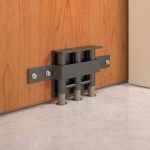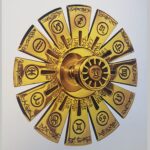.
Calling all architects…we need your help with this one!
 Someone asked me the other day how to tell from a set of floor plans which leaf of a pair is supposed to be the active leaf.
Someone asked me the other day how to tell from a set of floor plans which leaf of a pair is supposed to be the active leaf.
To get us all on the same page…
The active leaf of a pair is typically the one with a lockset, and the inactive leaf has flush bolts which secure that door at the top and bottom. When a pair of doors has panic hardware and one door has a key cylinder on the outside (and the other door doesn’t), that door would be called the active leaf even though both doors with panic hardware can be used for free egress. In some cases, both leaves of a pair are active leaves, and have the same hardware on each door.
So how do you know which leaf is supposed to be active and which is inactive? I have seen a few projects where the active/inactive leaves are designated by a symbol on the drawings, by the position of the door number, or by the degree of opening of each door (for example – active leaf drawn at 90 degrees, inactive drawn at 45), but in my experience this is not common. Right-hand-reverse active is the most common handing for pairs, but some pairs are LHR-active, RH-active, or LH-active (there’s more on handing here).
How common is it for architects to indicate the active leaf on the floor plan?
When the active leaf is chosen by the architect, how is it indicated?
If the architect does not indicate the active leaf, why not?
WWYD?
You need to login or register to bookmark/favorite this content.





I was told years ago that the leaf with the door number on it was the active but that doesn’t always happen on the floor plans. If the number is in the middle, we pick the one that has the least impact on traffic flow as the active.
Hum have not looked for that indication before.
I will from now on. I am thinking it is not indicated most of the time.
I would say the door hardware schedule should indicate it.
If the pair swings in default to RHA. If the doors swing out of the room default to RHRA. Only sometimes will this deviate to the same reasons as Lori listed above (one door is at a 45° angle, mark number on one door, it has a indicator on the plans, ect.).
Never noticed active leaf indication on drawings before. I have always indicated the active leaf in the in the hardware groups in the door hardware specifications. First line in hardware group would say “RHR Active Leaf” for example.
When electrified hardware is specified on one leaf,to determine which jamb is the power run to or card reader location, it must be coordinated in the detailing process to coordinate door and frame preps. The scheduling of the hardware normally seems to raise the question.
It’s not standard practice to note the active-leaf on our drawings. We tend to only consider it once we get the hardware schedule submittals from the contractor. It’s seriously a good idea to come up with something… I like the 90/45 degree swing idea. That would be flawless (great idea).
When I feel that it’s important to designate one leaf as active, a simple “AL” suffices.
The hardware schedule will list one door with prep for hardware. That same door should also show handing.
In my nearly 30 years working in the overly rewarding door/hardware industry, I can only recall seeing the active hand identified on the plans one time. I default to RHR active or RH active most of the time.
It certainly would be nice for the architect to note this but I’m afraid the plans are getting worse instead of better. I can’t tell you how many times I’ve received updated drawings (changes) with 2 or 3 sheets of door schedules and not one cloud indicating the changes. I’ve also seen more and more projects where the same door number is used for typical doors throughout the project (e.g. B01 for all stair doors or A9 for all electrical rooms). Inevitably, the next thing I’ll hear is that the doors need to be delivered in phases and by floor. Of course, each door tag will have different handing, different ratings and maybe even different sizes per floor. That means I have to create my own numbering system and provide that info back to the GC so they know what I’ve done (e.g. B01.1RC – for B01, 1st floor, RH, C-label). If there are two or more of these on the same floor it gets even uglier.
Lori, you asked why the architects don’t indicate the active leaf. Because they are doing less and less and demanding more and more and they don’t want anything to do with doors and hardware (they are smart in that respect). They leave it to those of us foolish enough to get trapped in this industry.
We do not indicate the active leaf on plans, nor in any schedules. Typically, a 45 degree door opening would signify an existing door on our plans, but it would also be halftoned (to indicate existing) which would also very uncommon to see a 90/45 swing combo in an opening with an existing/new leaf in the same frame.
We do try to indicate the active/inactive leaf within the door hardware groups. I find this approach to be very helpful and remove most of the assumptions from the submitting supplier and ensuring that 9/10 times the other potential electrical connections are installed properly.
I make the active leaf to open against a 90deg wall if it is there, otherwise the standard rhr/rh convention is used.
I always indicate the active leaf in the hardware schedule, never on the plans.
We handle it by the hardware sets in the spec. The hardware number ends up in the schedule. The door number and hardware number are coordinated between the two. We also add a general note in the door schedule, “inactive leaf, see specified hardware set”.
The only time I had to note the active/inactive leaf on a plan was for a small town building inspector who was a retired ICC employee.
The question is when and to whom you need to communicate the information. In my opinion, if you need to indicate the active leaf to communicate to your client or to your team during design, a comment on the door schedule may suffice. But where do you stop? You might have a note on your door schedule sheet like ACTIVE LEAF AT PAIRS OF DOORS TO BE RHR UON. But then you are obliged to comment on when both leaves are active.
To me, the folks you want to get it right are the installers. We add RHR ACTIVE, for example, on the line with the lockset in the HARDWARE SPECIFICATION. That gets the designation on the shops which are on site with the installers.
Regarding the lock side of the door, we locate doors on our schedules by FROM and TO columns. Our FROM heading is FROM (LOCK SIDE OF DOOR). Even if the supplier uses a different designation for To and FROM, restating that we call the FROM side the side with the lock gets us almost always the lock on the correct side. Note that this attention requires “hands on” attention
I have never seen door handing indicated on the floor plans issued from the architect for paired openings. Very few door schedules from IFC drawings indicate handing for any door.Drawings only show the swing of the door. I usually select handing when detailing the door schedules and hardware schedules for submission to the architect for approval. Handing is to be confirmed by the architect and should be based first, on evacuation routing within the means of egress. If a door does not open in the means of egress, I then default to RHRA. This will also be confirmed during the keying conference meetings with the client and the architect.
In the parts of the world that drive on the right side of the road, on pairs with exit devices, only the RHR leaf should have trim to avoid someone being hit by the LHR leaf as they approach it.
Drive right, walk right!
Side note, this can never apply at Costco. LOL!!
I was always taught, unless indicated on the door schedule or a note on the plans, the handing of the active leaf goes with the flow of traffic…literally. If you are in the US we drive on the right, so the active leaf is RH or RHR. In countries where they drive on the left…LH or LHR.
Handing is generally dictated by the side of the hall/corridor you walk down. When you walk down the Corridor on the right side you exit out the LHR leaf, thus leaving the RHRA leaf. This leaf would generally have the trim on the exterior. When you insert your key hopefully if everyone follows the rules you won’t get someone egressing through that leaf.
We do not indicate the active leaf on the plans, but our door schedules have a handing column, so it is always indicated there.
I can tell you that after 44+ years with The A. G. Mauro Company, I never had any architect designate which leaf is active on their plans, other than when they show unequal pairs. In that case, the wider door gets the lock and hand. Normally, we would choose the handing when detailing the finish hardware schedule. In a few very limited instances, the specific lock function and location of the door (say between two rooms) can lead to questions as to which leaf is active and which side is secured. So many variables, so little time. Anyway, in those cases, I would ask for verification during the submittal approval process and if I did not get a definitive answer, then I would ask the owner’s rep when conducting the keying meeting and/or during the more and more common security system & electric hardware meeting. I recommend that detailers also look at the wall elevations and building cross-sections. I had a door on a “busy” floor plan that opened from a mechanical room to the exterior roof. It was specified with a rim type exit device. When looking at a wall elevation, the door was not at floor level in the mechanical room. It was approx. 6 feet from the floor to the sill of the door opening and was accessed by a ships ladder- the type without a “cage”. Just imagine trying to use this door. To make matters worse, the roof level was about 12″ below the sill of the door opening. The floor plan was not large scale and the ships ladder was barely visible and had no written identification, so I can see how this was missed by the specifier. I brought this problem to the architect’s attention and he determined that this door was not a required exit and so, we changed the securing means from an exit device to a double-cylinder mortise lockset (with built-in deadbolt) for the maintenance staff’s use to access the roof-mounted equipment.
I’ve never seen active leaf designated on plans. I’ve variously noted it in hardware groups, door schedule, room elevations or door elevation detail, with the last being the most common.
On plans, existing doors get a 45 swing line, new doors get 90+ with 180 shown where egress requires a full swing, or ~120 shown where lobby door have a hold open position. Door tags go as close to parallel to latch as practical.
I show the active leaf open 90 degrees and the inactive leaf shown in the closed position, with it also shown dashed in the open position. I also put text indicating “active” and “inactive” on the respective leaf, makes it easy for our clients to understand and for our purchasing department when ordering.